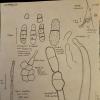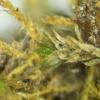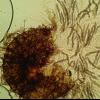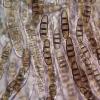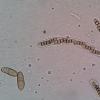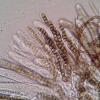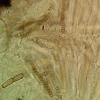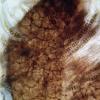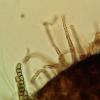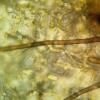
18-12-2025 21:17
Pol DebaenstThe identification took me to Byssonectria deformi

15-12-2025 07:09
 Danny Newman
Danny Newman
indet. Rutstroemiaceae sp. on unk. fallen leavesMc

19-12-2025 10:10
Patrice TANCHAUDBonjour, récolte réalisée en milieu dunaire, a

18-12-2025 17:23
 Bruno Coué
Bruno Coué
Bonjour,je serais heureux d'avoir votre avis sur c

18-12-2025 18:07
Margot en Geert VullingsThese plumes were found on rotten wood.They strong

17-12-2025 18:35
 Michel Hairaud
Michel Hairaud
Bonjour à tous/Hi to everyone I am passing along

15-12-2025 15:48
 Danny Newman
Danny Newman
Melanospora cf. lagenaria on old, rotting, fallen

15-12-2025 15:54
 Johan Boonefaes
Johan Boonefaes
Unknown anamorph found on the ground in coastal sa

15-12-2025 21:11
 Hardware Tony
Hardware Tony
Small clavate hairs, negative croziers and IKI bb
Lichenicolous Capronia?
Georges Greiff,
13-03-2022 13:09
Hi all,
Yesterday, I found what I think is a Capronia growing on decaying moss shoots (Amblystegium serpens and Tortula muralis) on a shaded wall. I think that an alga or lichen is growing on the moss, and the possible Capronia is growing on that. I have no idea about the species so any comments would be appreciated. Both teleomorph and anamorph appeared to be present.
Teleomorph: Ascomata up to ~100um diam, setose, solitary. Hairs brown below, occasionally branched below, paler above, walls verrucose, length seems variable, up to and in excess of 40um. Peridium outer cells textura angularis. Asci 8-spored, clavate-cylindrical, around 110 x 10, bitunicate. Mature ascospores brown, 3-septate, occasionally fragmenting even in asci - but I wouldn't call this species polysporous. Spore length and width increase somewhat during maturation, apparently along with the strength of the constrictions at the septa. Spores 11.5-13.6 x 3.4-3.9.
Anamorph: Conidiophores seem to be unbranched with verrucose walls. Some may form on top of the fruitbody from older hairs but I am not sure. Others were definitely beside the fruitbodies on the substrate. I think they were >100um long, 5 wide. Forming conidia apically in short chains but possibly also laterally. Conidia brown, verrucose, (0-)1-septate, 14.0-19.2 x 5.1-76.5(-7.2).
Any suggestions for ID or appropriate literature would be appreciated. If it is lichenicolous, I think the host could be a Lepraria. But I am not sure at all about the host preferences.
Thank you and best wishes,
George
Georges Greiff,
13-03-2022 17:20
Re : Lichenicolous Capronia?
An update. I returned to the site and collected more of this. It turns out that the fruitbodies are associated with the aerial mycelium of the moss parasite Acrospermum adeanum, which was attacking the moss substrates. I think it may therefore be parasitic on that. I noticed this mycelium previously but did not make the connection. A better sample nicely shows the co-occurance of the Capronia s.l. with the Acrospermum. I screened adjacent Lepraria populations and found them absent of the Capronia. Could still be wrong on the host specificity front but, given the mess of so many hyphae, I doubt I will be able to find convincing cellular evidence of the parasitism.
Georges Greiff,
14-03-2022 14:59
Re : Lichenicolous Capronia?
Another update:
This seems to fit with Bryosphaeria epibrya (Racov.) Döbbeler. Will investigate further.
Bryosphaeria epibrya (Racov.) Döbbeler Ascomata* 95-170 Brown Setose with brown, straight or slightly curved, septate hairs up to 50 long and 3-4 wide. Hairs lower on the fruitbody are more hypha-like. Looks glabrous unless under high magnification Narrowly cylindrical 8 (pseudo-32) Paraphysoids 1-2 wide, thread-like, branched, septate, sparse and fragmenting in mature fruitbodies Ellipsoidal (9-)10-13 x 3-4 Hyaline to brownish 3 (but disintegrating into 4 cells in asci) 4-celled spores dissociate into 4 individual cells = pseudo-32-spored asci; spore fragments apparently exuded from asci in a blackish-brown drop, possibly suggestive of a sheath. Hyphae Colourless to brownish.
Hosts: Anomodon rugelii; Didymodon rigidulus; Brachythecium sp.; Leskea polycarpa; Platygyrium repens; Pylaisia polyantha Saprophytic on decomposing, discoloured plants Döbbeler (1978); Racovitza (1959)
George
This seems to fit with Bryosphaeria epibrya (Racov.) Döbbeler. Will investigate further.
Bryosphaeria epibrya (Racov.) Döbbeler Ascomata* 95-170 Brown Setose with brown, straight or slightly curved, septate hairs up to 50 long and 3-4 wide. Hairs lower on the fruitbody are more hypha-like. Looks glabrous unless under high magnification Narrowly cylindrical 8 (pseudo-32) Paraphysoids 1-2 wide, thread-like, branched, septate, sparse and fragmenting in mature fruitbodies Ellipsoidal (9-)10-13 x 3-4 Hyaline to brownish 3 (but disintegrating into 4 cells in asci) 4-celled spores dissociate into 4 individual cells = pseudo-32-spored asci; spore fragments apparently exuded from asci in a blackish-brown drop, possibly suggestive of a sheath. Hyphae Colourless to brownish.
Hosts: Anomodon rugelii; Didymodon rigidulus; Brachythecium sp.; Leskea polycarpa; Platygyrium repens; Pylaisia polyantha Saprophytic on decomposing, discoloured plants Döbbeler (1978); Racovitza (1959)
George

